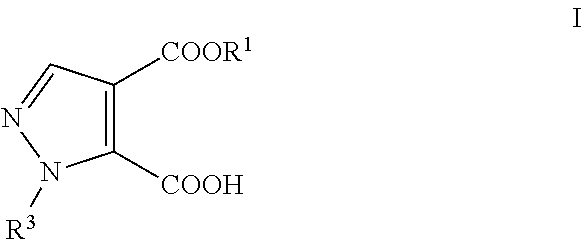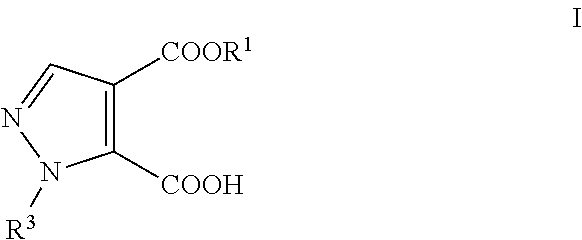Process for the preparation of pyrazole carboxylic acid derivatives
a technology of pyrazole carboxylic acid and derivatives, which is applied in the preparation of carbamic acid derivatives, organic chemistry, bulk chemical production, etc., can solve the problems of unsuitable synthesis methods and substantial amount of undesired n-1 substituted isomers
- Summary
- Abstract
- Description
- Claims
- Application Information
AI Technical Summary
Benefits of technology
Problems solved by technology
Method used
Image
Examples
example 1
[0064]2-[1-Dimethylamino-methylidene]-3-oxo-succinic Acid Diethyl Ester
[0065]Ethyl 2-chloro-2-oxoacetate (99 g, 725 mmol) was dissolved in 2-methyltetrahydrofuran (800 ml) and 4-(dimethylamino)-pyridine (1.25 g, 10.0 mmol) was added. The mixture was cooled to −5° C. and a solution of triethylamine (76.2 g, 753 mmol) and (E)-ethyl 3-(dimethylamino)acrylate (106 g, 740 mmol) in 2-methyltetrahydrofuran (70 ml) was added via dropping funnel. The mixture was stirred for 3 h at ca. 0° C. After that, 5% (m / m) aqueous sodium chloride solution (250 mL) was added, the mixture was concentrated in vacuo to remove the 2-methyltetrahydrofuran. Ethyl acetate (800 mL) and 5% (m / m) aqueous sodium chloride solution (250 mL) were added, the organic phase was washed with 5% (m / m) aqueous sodium chloride solution (4×250 mL), the combined aqueous layers reextracted with ethyl acetate (2×300 mL) and the combined organic extracts concentrated in vacuo. The residue was filtered over silica gel (500 g, eluti...
example 2
[0066]2-(N′-tert-Butoxycarbonyl-N′-methylhydrazinomethylene)-3-oxo-succinic Acid Di-Ethyl Ester
[0067]In a 1500 mL jacket controlled reaction flask equipped with mechanical stirrer, condenser and internal thermometer 2-[1-dimethylamino-meth-(Z)-ylidene]-3-oxo-succinic acid diethyl ester (73.2 g, 301 mmol) was dissolved in ethyl acetate (700 ml) and the solution was cooled to −5° C. A solution of N-tert-butoxycarbonyl-N-methylhydrazine (61.5 g, 421 mmol) in ethyl acetate (60 mL) was added dropwise within 45 min. The reaction mixture was stirred for 30 min at −5° C. Then, it was concentrated in vacuo to a volume of 100 mL and at a constant volume, solvent was exchanged with tert-butylmethylether (1.6 L), resulting in a thick suspension. More tert-butylmethylether (400 mL) was added, the suspension was stirred for 1 h at 0° C., filtered and the precipitate was washed with cold tert-butylmethylether (200 mL). After drying in vacuo (45° C., 20 mbar) the title compound was obtained as a co...
example 3
[0068]2-(N′-tert-Butoxycarbonyl-N′-methylhydrazinomethylene)-3-oxo-succinic Acid Diethyl Ester (Telescoped Process)
[0069]Process variant 1: In a 12 L jacket controlled vessel equipped with mechanical stirrer, condenser, internal thermometer and inert gas supply, ethyl 2-chloro-2-oxoacetate (192 g, 158 mL, 1.38 mol) was dissolved under argon at 20° C. in 2-methyltetrahydrofuran (1.34 L). DMAP (2.41 g, 19.3 mmol) was added as solid to the clear, colorless solution. The mixture was cooled to 2° C. internal temperature. A solution of (E)-ethyl 3-(dimethylamino)acrylate (179 g, 1.24 mol) in 2-methyltetrahydrofuran (960 mL) and triethylamine (154 g, 212 mL, 1.51 mol) was prepared in a separate flask by subsequent addition at room temperature, and added to the solution of ethyl 2-chloro-2-oxoacetate and DMAP at a rate that the internal temperature was kept at ca. 2° C. (cooling necessary). The mixture became cloudy, later a thick crystal mash (still stirrable). After 30 min stirring at 2° ...
PUM
| Property | Measurement | Unit |
|---|---|---|
| temperatures | aaaaa | aaaaa |
| temperatures | aaaaa | aaaaa |
| temperatures | aaaaa | aaaaa |
Abstract
Description
Claims
Application Information
 Login to View More
Login to View More - R&D
- Intellectual Property
- Life Sciences
- Materials
- Tech Scout
- Unparalleled Data Quality
- Higher Quality Content
- 60% Fewer Hallucinations
Browse by: Latest US Patents, China's latest patents, Technical Efficacy Thesaurus, Application Domain, Technology Topic, Popular Technical Reports.
© 2025 PatSnap. All rights reserved.Legal|Privacy policy|Modern Slavery Act Transparency Statement|Sitemap|About US| Contact US: help@patsnap.com



